Criminal Investigation Steven G. Brandl
Visit to download the full and correct content document: https://textbookfull.com/product/criminal-investigation-steven-g-brandl/
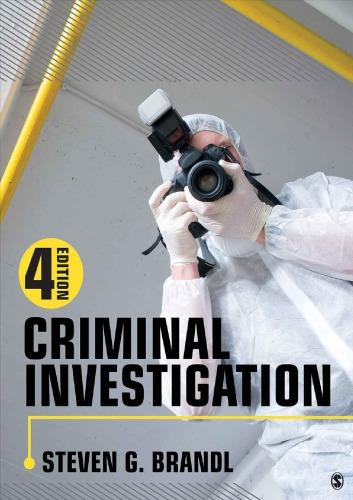
More products digital (pdf, epub, mobi) instant download maybe you interests ...
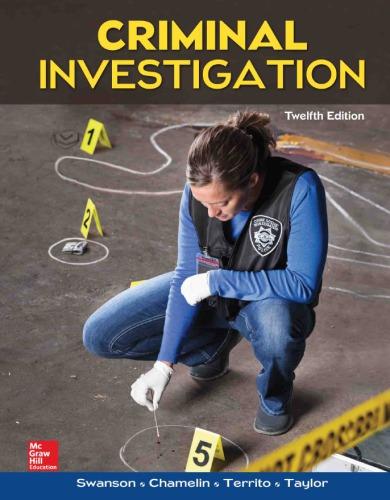
Criminal
Investigation Charles R. Swanson
https://textbookfull.com/product/criminal-investigation-charlesr-swanson/
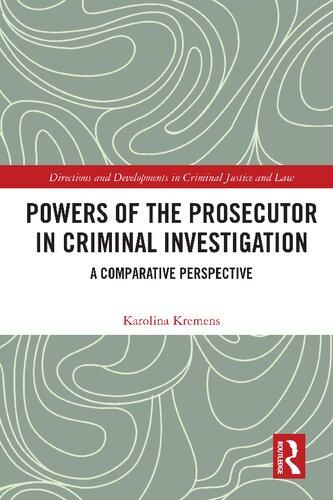
Powers of the Prosecutor in Criminal Investigation A Comparative Perspective 1st Edition Karolina Kremens
https://textbookfull.com/product/powers-of-the-prosecutor-incriminal-investigation-a-comparative-perspective-1st-editionkarolina-kremens/

Glioblastoma Steven Brem And Kalil G. Abdullah (Auth.)
https://textbookfull.com/product/glioblastoma-steven-brem-andkalil-g-abdullah-auth/
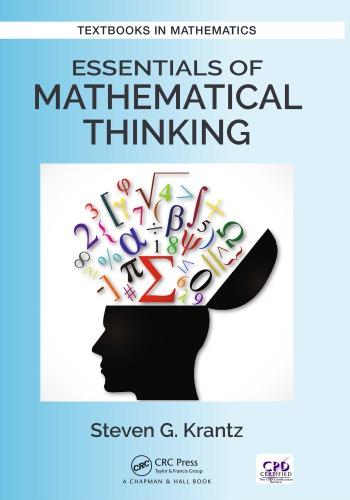
Essentials of Mathematical Thinking 1st Edition Steven G. Krantz
https://textbookfull.com/product/essentials-of-mathematicalthinking-1st-edition-steven-g-krantz/

Thermal Energy Systems: Design and Analysis Steven G
Penoncello
https://textbookfull.com/product/thermal-energy-systems-designand-analysis-steven-g-penoncello/
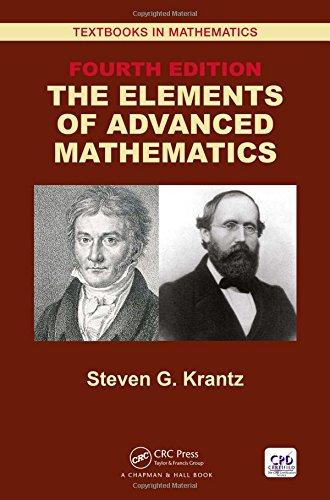
The Elements of Advanced Mathematics Fourth Edition
Steven G. Krantz
https://textbookfull.com/product/the-elements-of-advancedmathematics-fourth-edition-steven-g-krantz/

Thermal Energy Systems: Design and Analysis Second Edition Steven G. Penoncello
https://textbookfull.com/product/thermal-energy-systems-designand-analysis-second-edition-steven-g-penoncello/
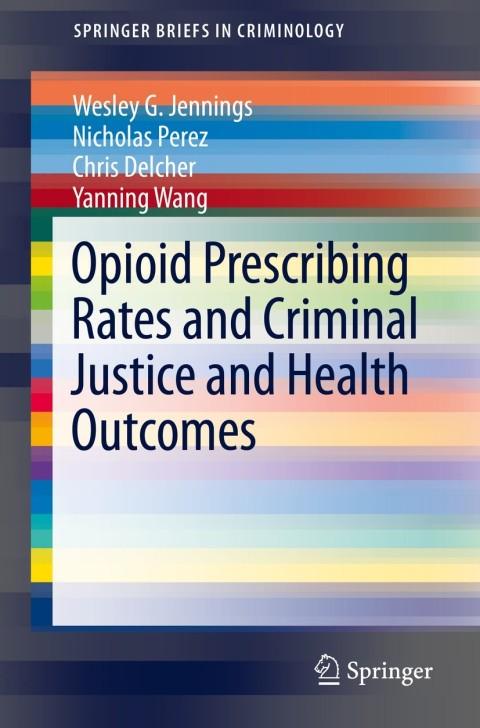
Opioid Prescribing Rates and Criminal Justice and Health Outcomes 1st Edition Wesley G. Jennings
https://textbookfull.com/product/opioid-prescribing-rates-andcriminal-justice-and-health-outcomes-1st-edition-wesley-gjennings/
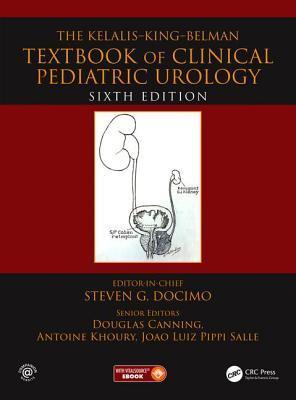
The Kelalis-King-Belman Textbook of Clinical Pediatric Urology 6th Edition Steven G. Docimo
https://textbookfull.com/product/the-kelalis-king-belmantextbook-of-clinical-pediatric-urology-6th-edition-steven-gdocimo/
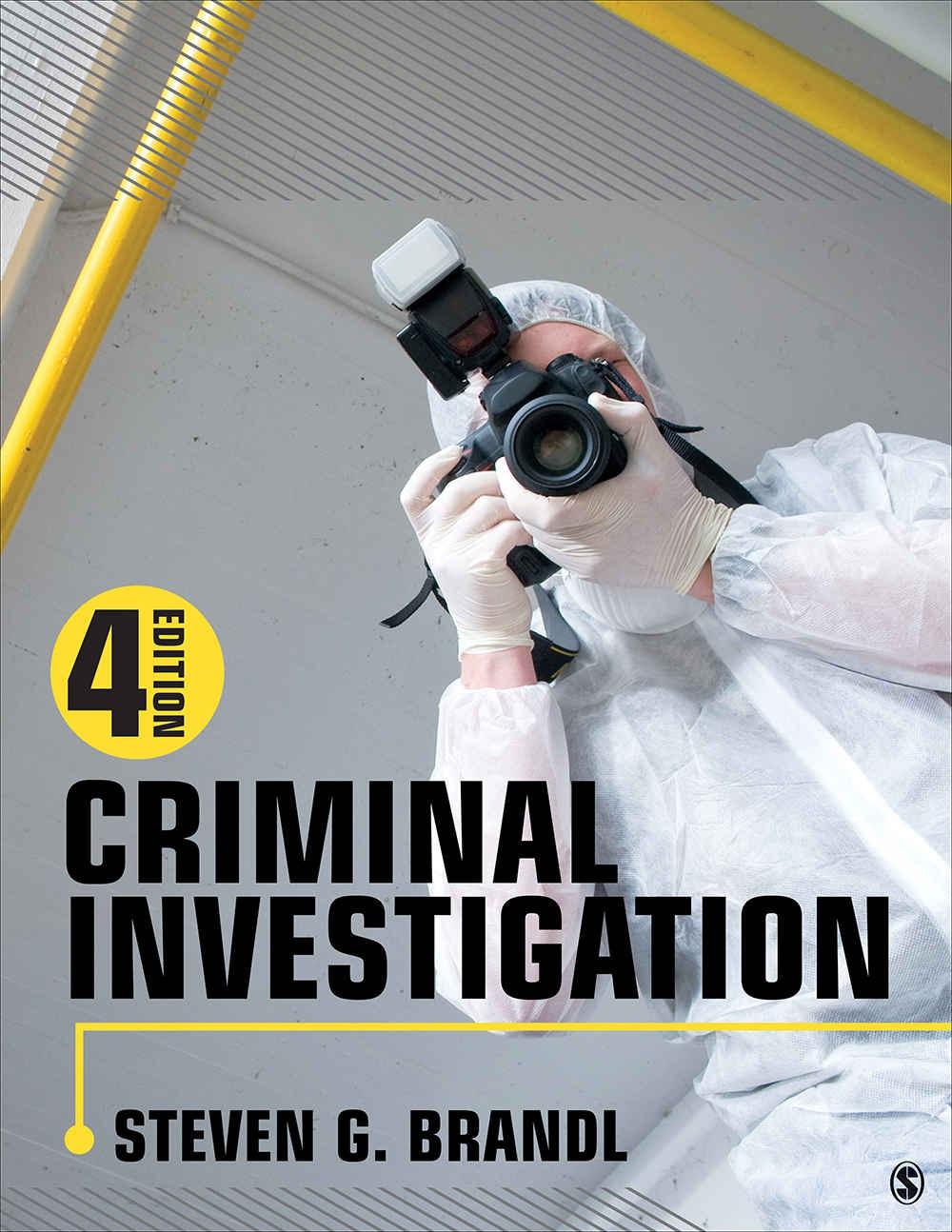

StevenG.Brandl
UniversityofWisconsin–Milwaukee


FORINFORMATION:
SAGEPublications,Inc
2455TellerRoad
ThousandOaks,California91320
E-mail:order@sagepubcom
SAGEPublicationsLtd
1Oliver’sYard
55CityRoad
LondonEC1Y1SP
UnitedKingdom
SAGEPublicationsIndiaPvt Ltd
B1/I1MohanCooperativeIndustrialArea MathuraRoad,NewDelhi110044
India
SAGEPublicationsAsia-PacificPte Ltd
3ChurchStreet
#10–04SamsungHub Singapore049483
Copyright©2019bySAGEPublications,Inc
Allrightsreserved Nopartofthisbookmaybereproducedorutilizedinanyformorbyanymeans, electronicormechanical,includingphotocopying,recording,orbyanyinformationstorageandretrieval system,withoutpermissioninwritingfromthepublisher
Alltrademarksdepictedwithinthisbook,includingtrademarksappearingaspartofascreenshot,figure,or otherimageareincludedsolelyforthepurposeofillustrationandarethepropertyoftheirrespectiveholders. Theuseofthetrademarksinnowayindicatesanyrelationshipwith,orendorsementby,theholdersofsaid trademarks
PrintedintheUnitedStatesofAmerica
LibraryofCongressCataloging-in-PublicationData
Names:Brandl,StevenG (StevenGerard)author
Title:Criminalinvestigation/StevenG.Brandl,UniversityofWisconsin,Milwaukee.
Description:FourthEdition.|ThousandOaks:SAGEPublications,[2018]|Revisededitionoftheauthor’sCriminalinvestigation,[2014]| Includesbibliographicalreferencesandindex
Identifiers:LCCN2017038234|ISBN9781506391410(pbk :alk paper)
Subjects:LCSH:Criminalinvestigation
Classification:LCCHV8073 B6732018|DDC36325 dc23LCrecordavailableathttps://lccnlocgov/2017038234
Thisbookisprintedonacid-freepaper
AcquisitionsEditor:JessicaMiller
ContentDevelopmentEditor:NedaDallal
EditorialAssistant:RebeccaLee
MarketingManager:JillianRagusa
ProductionEditor:VeronicaStapletonHooper
CopyEditor:ShannonKelly
Typesetter:C&MDigitals(P)Ltd
Proofreader:WendyJoDymond
Indexer:BethNauman-Montana
CoverDesigner:ScottVanAtta
BriefContents
Preface
Acknowledgments
AbouttheAuthor
Chapter1:TheInvestigationofCrime
Chapter2:TheHistoryofCriminalInvestigation
Chapter3:TheRoleandDocumentationofEvidenceinCriminalInvestigations
Chapter4:TheLawandCriminalInvestigations
Chapter5:PhysicalEvidenceandtheCrimeScene
Chapter6:InterviewsandEyewitnessIdentifications
Chapter7:InterrogationsandConfessions
Chapter8:BehavioralEvidenceandCrimeAnalysis
Chapter9:InformationFromthePublic,SocialMedia,InformationNetworks,DigitalDevices,and OtherSources
Chapter10:DeathInvestigation
Chapter11:TheInvestigationofSexCrimes,Assault,ChildAbuse,andRelatedOffenses
Chapter12:TheInvestigationofRobbery
Chapter13:TheInvestigationofBurglary,VehicleTheft,Arson,andOtherPropertyCrimes
Chapter14:TheInvestigationofFraudandOtherComputer-RelatedCrimes
Chapter15:ThePresentationofEvidence
Chapter16:Terrorism,Technology,andtheFutureofCriminalInvestigation
Appendix:CapstoneCase
Glossary
Notes
Index
DetailedContents
Preface
Acknowledgments
AbouttheAuthor
Chapter1:TheInvestigationofCrime Objectives
FromtheCaseFile:TheInvestigationoftheWashington,DC,BeltwaySnipers CaseConsiderationsandPointsforDiscussion
CriminalInvestigation,Evidence,andForensicScienceDefined MythsandMisconceptions11:“CrimeTime”Television TypesofCriminalInvestigations
ReactiveInvestigations
UndercoverInvestigations
MythsandMisconceptions1.2:TheRoleofPatrolOfficersinSolvingCrimes PerspectivesontheCriminalInvestigationProcess
MythsandMisconceptions13:“AreYouaPoliceOfficer?” CriminalInvestigationasaBattle CriminalInvestigationasaGame
CaseinPoint11:BTKandtheComputerDisk CriminalInvestigationasaPuzzle
TheRoleofChance,Accident,andDiscoveryinCriminalInvestigations
MentalMistakesinCriminalInvestigations
CaseinPoint1.2:TheIdentificationandApprehensionofTimothyMcVeigh QualitiesandCharacteristicsofInvestigations
CriminalInvestigationandtheCriminalJusticeSystem MainPoints
ImportantTerms
QuestionsforDiscussionandReview
Chapter2:TheHistoryofCriminalInvestigation Objectives
FromtheCaseFile:TheLindberghBabyKidnapping CaseConsiderationsandPointsforDiscussion
TheImportanceofHistoryinUnderstandingthePresentandtheFuture
TheEvolutionoftheInvestigativeTask:EnglishDevelopments InformersandParliamentaryReward
Thief-Takers
Thief-Makers
LondonMetropolitanPoliceDepartment
TheEvolutionoftheInvestigativeTask:AmericanDevelopments
TheFirstAmericanPoliceDepartmentsandDetectives
MythsandMisconceptions2.1:TheOriginalCSI
Sheriffs,StatePolice,U.S.Marshals,andtheBureauofInvestigation
PrivateDetectives
TheReformEra
TheCommunityProblem-SolvingEra
MythsandMisconceptions22:TheMythologyoftheFederalBureauofInvestigation
MainPoints
ImportantTerms
QuestionsforDiscussionandReview
Chapter3:TheRoleandDocumentationofEvidenceinCriminalInvestigations Objectives
FromtheCaseFile:TheMurderofStanleyVanWagner CaseConsiderationsandPointsforDiscussion
TheBasicsofCriminalEvidence
JudicialandExtrajudicialEvidence
ExculpatoryandInculpatoryEvidence
StandardsofProof
TheMeaningandNatureofProbableCause TypesofEvidence
DirectversusIndirectEvidence
CaseinPoint31:“AllThisWasPlannedWhentheFirstShotWasFired” MythsandMisconceptions31:CircumstantialEvidenceIsNotVeryUseful Testimonial,Real,Demonstrative,andDocumentaryEvidence
CaseinPoint32:EvidenceorCoincidence?
TestimonialEvidence
RealEvidence
DemonstrativeEvidence
CaseinPoint33:AHomicideVictim’sLettertothePolice
DocumentaryEvidence
TheFunctionsofEvidence
CorpusDelictiEvidence
CorroborativeEvidence
CumulativeEvidence
AssociativeEvidence
IdentificationEvidence
BehavioralEvidence
DocumentingEvidence:TheValueandImportanceofInvestigativeReports
MainPoints
ImportantTerms
QuestionsforDiscussionandReview
Chapter4:TheLawandCriminalInvestigations
Objectives
FromtheCaseFile:ErnestoMiranda’sConfession
CaseConsiderationsandPointsforDiscussion
BasicLegalTerminology
TheBottomLine:WhenIsanArrestWarrantNecessary?
TheBottomLine:WhenIsaSearchWarrantNecessary?
TheRulesandAdmissibilityofEvidence
ConstitutionalRequirementsfortheCollectionofEvidence
AQuestionofEthics:FudgingaChainofCustody
TheLawofSearchandSeizure:TheFourthAmendment
ReasonableExpectationofPrivacy
TheSearchWarrantRequirementandItsExceptions
TheBottomLine:WhenDoestheExigentCircumstancesExceptionApply?
TheBottomLine:WhenDoestheVehicleExceptionApply?
Exhibit41:GuidelinesforStoppingandSearchingVehicles
TheBottomLine:WhatPlacesandThingsAreNotAffordedaReasonableExpectationof Privacy?
TheBottomLine:WhenDoestheHotPursuitExceptionApply?
TheBottomLine:WhenDoestheSearchIncidenttoArrestExceptionApply?
TheBottomLine:WhenDoestheStopandFriskExceptionApply?
TheBottomLine:WhenDoesthePlainViewExceptionApply?
TheBottomLine:WhenDoestheConsentExceptionApply?
TheExclusionaryRuleandItsExceptions
TheBottomLine:WhatIstheExclusionaryRule,andWhenDoesItApply?
AQuestionofEthics:DotheEndsJustifytheMeans?
TheLawofSelf-Incrimination:TheFifthandSixthAmendments
TheContentandWaiverofMirandaWarnings
Exhibit4.2:ExampleofaMirandaWaiverForm
Myths&Misconceptions41:MirandaIsNotLikeHoudini
WhatConstitutesanInterrogation?
TheImplicationsofSilence
TheBottomLine:WhenMustthePoliceTellSuspectsofTheirMirandaRights?
JuvenilesandtheMirandaRequirement
ExceptionstotheMirandaRequirement
TheImpactofMirandaWarningsonCriminalInvestigations
Myths&Misconceptions42:MirandaWarningsCauseSuspectstoKeepQuiet MainPoints
ImportantTerms
QuestionsforDiscussionandReview
Chapter5:PhysicalEvidenceandtheCrimeScene Objectives
FromtheCaseFile:TheMurdersofNicoleBrownSimpsonandRonaldGoldman
CaseConsiderationsandPointsforDiscussion
TheRoleofPhysicalEvidenceinCriminalInvestigations
TheCrimeSceneandItsManagement
ArrivingattheScene:InitialResponse/PrioritizationofEfforts
PreliminaryDocumentationandEvaluationoftheScene
ProcessingtheScene
Exhibit5.1:CrimeSceneSketchandDiagram
CompletingandRecordingtheCrimeSceneInvestigation
CaseinPoint51:CrimeScenePhotographsShouldTellaStory TypesofPhysicalEvidence
Exhibit5.2:CrimeSceneSearchPatterns
BiologicalEvidence
Blood
Exhibit5.3:LocatingDNAEvidence
Semen
CaseinPoint53:AnImprobableDiscoveryofSemen
Saliva
Hair
CaseinPoint54:SalivaonaCigaretteButt
CaseinPoint5.5:SalivaonDuctTape
OtherBodilyFluidsandSubstances
FingernailScrapings,SkinCells,andTouchDNA
DNAAnalysisandItsImpactontheUsefulnessofBiologicalEvidence
CaseinPoint56:DNAUndertheVictim’sFingernails
Exhibit54:PrecautionsWhenCollectingandHandlingBiologicalEvidence
TheScienceofDNA
CaseinPoint57:AFool’sAttempttoFoolDNA
OtherTypesofPhysicalEvidence
Fingerprints
CaseinPoint58:ATextbookDNACase
Exhibit55:TypesofFingerprintPatterns
Exhibit5.6:ExampleofCompletedTen-PrintFingerprintCard Shoeprints,Impressions,andTireTracks
Exhibit57:UnusualShoeprints
Toolmarks
BiteMarksandDentalEvidence
Ballistics
Fibers
Soil
Paint
Glass
BloodPatternAnalysis
DigitalEvidence
VideoEvidence
QuestionedDocuments/HandwritingAnalysis
Drugs
TheRoleofCrimeLaboratoriesinCriminalInvestigations
ForensicScienceSpecialtyAreas
Exhibit58:CharacteristicsofDrugsMostCommonlyEncounteredontheStreet
Exhibit5.9:JobAnnouncementforaForensicCriminalistPosition
MainPoints
ImportantTerms
QuestionsforDiscussionandReview
Chapter6:InterviewsandEyewitnessIdentifications
Objectives
FromtheCaseFile:BPGasStationRobbery CaseConsiderationsandPointsforDiscussion
InterviewsDefined
TypesofWitnesses
TypesofInformationObtainedFromWitnesses
MethodsofEyewitnessIdentification
DevelopmentofaCompositePictureofthePerpetrator
Exhibit6.1:ExampleofaCompositePictureDevelopedWithFACESSoftware
Exhibit62:ExampleofArtistCompositePicture
ConfirmatoryPhotograph
MugBooksandYearbooks
Exhibit63:FourSketchesoftheSamePerpetrator
Show-UpIdentifications
PhotoLineups
Exhibit64:ExampleofaSix-PersonPhotoLineup LiveLineups
ValueofEyewitnessIdentificationsinEstablishingProof
Exhibit65:ExampleofaLiveLineupPhoto
TheMemoryProcessandtheIdentificationTask
MythsandMisconceptions6.1:YouNeverForgetaFace
FactorsThatInfluencetheAccuracyofEyewitnessEvidence
CaseinPoint61:AShoot-OutorSomethingElse?
GuidelinesfortheCollectionofEyewitnessEvidence
CaseinPoint6.2:HowDidThatHappen?
CaseinPoint63:TheCaseofRonaldCotton
CaseinPoint6.4:VariationsinEyewitnessDescriptions
InvestigativeToolsinInterviewing Hypnosis
Exhibit6.6:PhotoArrayIdentificationInstructionForm CognitiveInterview
CognitiveInterviewinContrastWiththeStandardPoliceInterview OtherGuidelinesforConductingPoliceInterviews
CaseinPoint6.5:WitnessSecurityversusWitnessCompassion
MainPoints
ImportantTerms
QuestionsforDiscussionandReview
Chapter7:InterrogationsandConfessions Objectives
FromtheCaseFile:The“Secret”InterrogationofO.J.Simpson CaseConsiderationsandPointsforDiscussion InterrogationsDefined
TheControversyofInterrogationMethods
PrerequisitesforaProductiveInterrogation
CaseinPoint71:“EveryTimeWeDoSomethingIllegal,I’mtheOneWhoHastoDoIt” Exhibit7.1:TruismsAboutConfessions ApproachestoInvestigativeInterrogations
TheReidTechnique:The“ConvincetoConfess”Approach ThePEACEModel:The“RespectfortheTruth”Approach MythsandMisconceptions71:InterrogationsInvolveBrightLightsandHotRooms CaseinPoint72:TreatingaKillerKindly
ThePotentialProblemsWithPoliceDeceptioninInterrogations
CaseinPoint73:“We’reGoingtoWorkThroughThisTogether Okay?”
AQuestionofEthics71:ShouldthePoliceLietoGetSuspectstoTelltheTruth? WhyDoSuspectsConfess?
TheIssueofFalseConfessions
InvestigativeToolsinRecognizingDeception VerbalandNonverbalDetectionofDeception
Exhibit72:“TheBestWaytoUnsettleaSuspect” MechanicalMethodsofDetectingDeception MainPoints
ImportantTerms
QuestionsforDiscussionandReview
Chapter8:BehavioralEvidenceandCrimeAnalysis
Objectives
FromtheCaseFile:AMutilationMurder
TheCrime
KeyCrimeSceneCharacteristics
TheResultingCrimeSceneProfile
TheOutcome
CaseConsiderationsandPointsforDiscussion
BehavioralAnalysisDefined
CrimeSceneProfiling
MythsandMisconceptions8.1:CriminalMinds
AssumptionsoftheProfilingProcess
Exhibit8.1:WhatDoesYourCarSayAboutYou?
TheHistoryofCrimeScene/PsychologicalProfiling
TheConstructionofPsychologicalProfiles
TheMeaningofPerpetratorActionsandCrimeCharacteristics
TheEffectivenessofCrimeSceneProfiling
GeographicalProfiling
Exhibit82:WhereDoYouGoGroceryShopping?
Psycholinguistics
CaseinPoint81:TheMurderofJonBenetRamsey
CrimeAnalysis
TheImpactofGeospatialCrimeAnalysis
MythsandMisconceptions82:CrimeIsaRandomPhenomenon
ViolentCriminalApprehensionProgram(ViCAP)
TheImpactofViCAP
EmpiricalCrimeAnalysis
MainPoints
ImportantTerms
QuestionsforDiscussionandReview
Chapter9:InformationFromthePublic,SocialMedia,InformationNetworks,DigitalDevices,and OtherSources
Objectives
FromtheCaseFile:“Ain’tNoLoveintheHeartoftheCity”
CaseConsiderationsandPointsforDiscussion
InformationFromthePublicinCriminalInvestigations
TipLines
TelevisionShows
AMBERAlerts
CaseinPoint91:AnAMBERAlertSuccessStory
CaseinPoint9.2:AnotherAMBERAlertSuccessStory
CaseinPoint9.3:TheMurderofCarlieBrucia CodeAdam
OtherMethodsofSolicitingInformationFromthePublic Limitations
InformationFromSocialMediainCriminalInvestigations
CaseinPoint9.4:ARobberRecognizedonFacebook
Exhibit9.1:ExamplesofIncriminatingStatementsMadeonFacebook ConfidentialInformants
GangIntelligence WhatIsaGang?
Exhibit92:TipsforHandlingInformants StreetGangs
Exhibit9.3:TheBasicsofGangGraffiti OutlawMotorcycleGangs
InvestigativeResponsetoGangs InformationNetworks
IntradepartmentalandRegionalDatabases InterdepartmentalDatabases
Limitations
InformationFromElectronicDevicesandDigitalEvidence
CaseinPoint95:“SheIsSoRaped”
CaseinPoint9.6:AKillerIdentifiedviaanIPAddress
SeizingElectronicDevicesandComputerDataExtraction
CaseinPoint97:FindthePhone,FindtheGirlandMore Psychics
MainPoints
ImportantTerms
QuestionsforDiscussionandReview
Chapter10:DeathInvestigation Objectives
FromtheCaseFile:HeHitHerUntilSheFell...andThatWasJusttheBeginning CaseConsiderationsandPointsforDiscussion IssuesintheInvestigationofDeath:MannerofDeath
Exhibit10.1:QuickFactsAboutDeath
Exhibit102:LocationofGunshotWoundsinHomicidesandSuicides PatternsandCharacteristicsofHomicide MythsandMisconceptions10.1:TheMethodsofMurder
InvestigativeConsiderationsWithDeathandHomicide
Exhibit103:DecliningHomicideClearanceRates
WhoIstheDecedent?
WhatWastheCauseofDeath?
Exhibit104:TypesandIndicatorsofGunshotWoundsbyMuzzletoSkinDistance
TheValueofanAutopsyinEstablishingCauseandMannerofDeath WhoCommittedtheMurder?
CaseinPoint101:AutopsyProtocolofAnthonyPorter,HomicideVictim CaseinPoint10.2:ThingsAreNotAlwaysasTheySeem MajorChallengesinHomicideInvestigations:SerialHomicide MajorChallengesinHomicideInvestigations:ColdCases CaseinPoint10.3:ColdCaseCleared
MainPoints
ImportantTerms
QuestionsforDiscussionandReview
Chapter11:TheInvestigationofSexCrimes,Assault,ChildAbuse,andRelatedOffenses Objectives
FromtheCaseFile:“SinceYouDon’tHaveAnyMoney ” CaseConsiderationsandPointsforDiscussion
VarietiesandCharacteristicsofRapeandOtherSexualAssaults InvestigativeConsiderationsWithRapeandOtherSexualAssaults ThePerspectiveoftheVictim
MythsandMisconceptions111:TheCircumstancesofRape
ThePoliceResponseandInterviewoftheVictim
CaseinPoint11.1:“MyStepbrotherAssaultedMe” CaseinPoint112:OneThingLeadstoAnotherandaRapeIsSolved PhysicalEvidence
Drug-FacilitatedSexualAssaults
InformationFromPerpetrators:PhysicalEvidenceandConfessions OtherSourcesofEvidenceandInformationinSexualAssaultInvestigations FalseAllegations
VarietiesandCharacteristicsofOtherAssaults
Exhibit111:WhatIsaGang-RelatedCrime?
InvestigativeConsiderationsWithOtherAssaults
Anti-SnitchingNormsandReluctantWitnesses
Exhibit112:TheProblemofWitnessIntimidation DomesticViolenceandChildAbuse
Domestic(andIntimatePartner)Violence
ChildAbuse
MainPoints
ImportantTerms
QuestionsforDiscussionandReview
Chapter12:TheInvestigationofRobbery
Objectives
FromtheCaseFile:TheRobberWhoLostHisTool CaseConsiderationsandPointsforDiscussion
VarietiesandCharacteristicsofRobbery
InvestigativeConsiderationsWithRobbery
MythsandMisconceptions12.1:OnlytheBestandBrightestRobBanks HoldupAlarmsandaFastPoliceResponse
EyewitnessIdentificationsandCCTV
ModusOperandi
TheMeaningofTargetSelection
CaseinPoint121:ARobberyInvestigationBeginsWiththeMO TheRobber’sApproachandDeparture VerbalActivityoftheRobber
TheWeaponandDisguiseUsed
PhysicalEvidence
CaseinPoint12.2:TheThiefWho“BlewIt”
ThePropertyTakenintheRobbery
InterrogationConsiderations
OtherStrategiesandSourcesofInformation
MainPoints
ImportantTerms
QuestionsforDiscussionandReview
Chapter13:TheInvestigationofBurglary,VehicleTheft,Arson,andOtherPropertyCrimes
Objectives
FromtheCaseFile:DadandDaughterGotoWork CaseConsiderationsandPointsforDiscussion
VarietiesandCharacteristicsofBurglaries
InvestigativeConsiderationsWithBurglary
BurglarAlarmsandtheInitialPoliceResponse
ModusOperandi
MethodofTargetSelection
MethodofEntry
AmountofPre-OffensePlanning
MethodofSearchforProperty
ChoiceofPropertyTaken
InvestigativeValueoftheStolenProperty
PhysicalEvidence
Informants
OtherConsiderations
VarietiesandCharacteristicsofVehicleTheft
InvestigativeConsiderationsWithVehicleTheft MythsandMisconceptions131:ExpensiveCarsAretheMostFrequentlyStolen PoliceOfficersontheLookout,VINs,andLicensePlateReader(LPR)Technology PhysicalEvidence
ModusOperandi:MotiveandMethod
EyewitnessesandCCTVSurveillanceCameras
TheUseofBaitCars
InvestigativeTaskForces
VarietiesandCharacteristicsofArson InvestigativeConsiderationsWithArson
RespondingtotheFireScene:InitialInvestigativeActivities
EvidencetoDeterminetheCauseoftheFire
Exhibit13.1:IndicatorsofArsonasaFireCause PointofOrigin
EvidencetoDetermineWhoCommittedtheArson CaseinPoint13.1:ASuspiciousFire
VarietiesandCharacteristicsofLarceny
InvestigativeConsiderationsWithLarceny
Exhibit13.2:CrimeSolversPressRelease
InterrogationConsiderationsWithBurglars,Arsonists,andOtherThieves MainPoints
ImportantTerms
QuestionsforDiscussionandReview
Chapter14:TheInvestigationofFraudandOtherComputer-RelatedCrimes Objectives
FromtheCaseFile:AnInternetChatWithanUndercoverOfficer CaseConsiderationsandPointsforDiscussion
FraudandItsInvestigation
IdentityTheft
CaseinPoint141:“VisitMe!”
Exhibit14.1:“YourAccountHasWon1,000,000.00”
Exhibit142:WhatDoestheFACTActDo?
CheckandCredit/DebitCardFraud
Exhibit14.3:StepstoTakeWhenYourIdentityHasBeenStolen
Exhibit144:TheFTCConsumerSentinel
PrescriptionFraud
CaseinPoint14.2:Theft,Purchase,andArrest
VarietiesofComputer-FacilitatedCrimeandTheirInvestigation Cyberattacks
Exhibit14.5:OneoftheFBI’sMostWantedCyberCriminals CyberbullyingandHarassment
Exhibit146:CommonFormsofCyberattacks
CaseinPoint14.3:“YouAreaBadPersonandEverybodyHatesYou” CaseinPoint14.4:“I’mGoingtoSendoutthePhotosUnless...” ChildPornography
CaseinPoint14.5:ABigArrestFromLittleClues
MainPoints
ImportantTerms
QuestionsforDiscussionandReview
Chapter15:ThePresentationofEvidence
Objectives
FromtheCaseFile:ATragedyandThenMore CaseConsiderationsandPointsforDiscussion
TheAdversarialProcess
ErrorsinJusticeOutcomes
TheSeriousnessofErrorsinJusticeOutcomes ReasonsforErrorsinJusticeOutcomes
CaseinPoint151:TheCaseofEddieJoeLloyd
AQuestionofEthics:WhyIsItOkaytoLieSometimesbutNotOtherTimes?
TheValueandImportanceofInvestigativeTestimony
ExpertTestimony
TestimonyofInvestigators
TestimonyattheDeposition,PreliminaryHearing,andTrial TheCross-Examination
AQuestionofEthics:WhySoManyLegalRules?
MainPoints
ImportantTerms
QuestionsforDiscussionandReview
Chapter16:Terrorism,Technology,andtheFutureofCriminalInvestigation Objectives
FromtheCaseFile:TheDaytheWorldChanged CaseConsiderationsandPointsforDiscussion
AQuestionofEthics:InformationatAnyCost?
TheFutureofCriminalInvestigation
VarietiesandCharacteristicsofTerrorism
Technology
Exhibit16.1:VariationsinTerrorism
CaseinPoint16.1:A35,000-WordClueFromaLoneWolf
Exhibit162:Terrorists’ToolsandTargets
MythsandMisconceptions16.1:FalsitiesAboutTerrorismintheUnitedStates
ANewApproachtoCriminalInvestigations
Exhibit163:CommonTypesofCybercrimes Intelligence-LedPolicing
Exhibit16.4:TerroristGroupStructure
CaseinPoint162:InformationDiscoveryAftertheFact
Exhibit16.5:SevenSignsofTerroristActivity
LimitationsoftheIntelligence-LedApproach
TheNewTechnologyofCrimeDetection
TheTechnologyofIdentificationandForensicScience
AQuestionofEthics:WhyAreSomeBiometricTechnologiesSoControversial?
TheTechnologyof“Seeing”
TechnologiesforComputerandInternetApplications TechnologiesforInformationManagementandAccess
TheImplicationsofTechnology
MainPoints
ImportantTerms
QuestionsforDiscussionandReview
Appendix:CapstoneCase
Glossary
Notes
Index
Preface
Criminalinvestigationisarguablythemostimportantstageintheentirecriminaljusticeprocess Onlywhena perpetratorisidentifiedandapprehendedcantheprocesscontinue cancourtsadjudicateandcorrections reform.Anditisonlywhentheprocesscontinuesthatthereisevenachancepotentialoffenderswillbe deterredandactualoffendersincapacitated Asdiscussedinthisbook,therearemanyfactorsthatdetermine whetheroffendersareidentifiedandapprehended,andwell-executedcriminalinvestigationsareatthetopof thislist.Assuch,ifwedesireacriminaljusticeprocessthatfunctionswell,itisnecessarythatcriminal investigatorshavetherequisiteknowledge,education,andtrainingtoconductcompetentinvestigations
Althoughitisnotrealistictoexpectthisknowledgecanbeobtainedinasinglecourse(orfromasingle textbook)oncriminalinvestigations,suchacourse(andtextbook)canplayanextremelyimportantrolein developingit.CriminalInvestigationprovidesabasisforcompetentinvestigations.
Toachievethis,thetextfocusesonmanydifferentaspectsofcriminalinvestigationandevidence Criminal investigationandcriminalevidencegohandinhand;theyareinseparable Criminalinvestigationsare conductedtocollectcriminalevidence,anditisevidencethatisusedtoestablishproofinaninvestigation. Investigatorsmustunderstandtheroleandfunctionofevidence,thestrengthsandweaknessesofvarious formsofevidence,howdifferenttypesofevidencecanbeusedtoestablishproof,thelegalissuesthatrelateto thecollectionofevidence,andbestpracticesforthecollectionofevidence.CriminalInvestigationprovidesthis knowledge
CriminalInvestigationalsoemphasizestherealworldofinvestigations Acommonandimportantmethodof learningandinstructionincriminalinvestigationisthereviewandanalysisofactualcases.Caseexamplesare usedasteachingtoolsininvestigativeseminarsandintraining Investigatorslearnthingsfromevery investigation,andthistextemphasizesthisapproach Manycaseexamplesareprovidedinthetexttoillustrate keypointsandtoprovideabasisfordiscussionabouttheproperconductofcriminalinvestigations.These detailedcasesbringthediscussiontolifeandmakeitrelevantandinteresting
Anunderstandingofforensicscienceisalsocriticallyimportantindevelopingcompetenceincriminal investigations Thismaterialisincludedinthisbook;however,CriminalInvestigationisnotaforensicscience text.Themostimportantandcomplexforensicscienceproceduresandissuesarediscussedhere,butnotatthe sacrificeofotherimportantmaterial CriminalInvestigationisnotaninstructionmanual Step-by-step instructionsaremostappropriatelylearnedininvestigativetrainingcoursesafterafoundationof understandinghasbeendeveloped.
Thistextemphasizesresearchfindingsthatrelatetocriminalinvestigations Suchfindingsareusedtoidentify andrecommendbestpractices(procedures)tofollowincriminalinvestigations Familiaritywithresearch findingsalsoallowsonetodevelopasolidunderstandingoftheissuesunderexamination.Oneexampleofthis canbefoundinthediscussiononeyewitnessidentifications Thisbookdevotesthebetterpartofachapterto eyewitnessidentifications However,insteadofjustprovidinginstructionsonhowtoconductthese
identifications,CriminalInvestigationalsoprovidesadiscussionoftheresearchsupportingtherecommended procedures Toaccomplishthis,thediscussiondrawsuponresearchonhumanmemoryaswellason eyewitnessidentifications.Assuch,CriminalInvestigationnotonlyprovidesdetailsregardingthecollectionof eyewitnessevidence;italsoexplainswhytheseproceduresareimportant.Issuessuchasthisreceiveminimal,if any,coverageinothercriminalinvestigationtexts Thesedeeper,moreprobingquestionsarewhatleadtoa greaterunderstandingofcriminalinvestigationprocedures.Byincorporatingresearchfindingsintothe discussion,thisbookprovidesaneducationaboutcriminalinvestigations.
JustbecauseCriminalInvestigationemphasizesresearchfindingsandevidence,however,thisdoesnotmean thetextiscomplicatedordifficulttoread Tothecontrary;thetextisveryaccessibletostudentsandiswritten inastraightforwardmanner.
CriminalInvestigationisofreasonablelengthforaone-semestercourse Manyinstructors,includingmyself, havehaddifficultiesteachingfromever-expandingcriminalinvestigationbooks,andstudentsoftenhave difficultiesinlearningfromthem.Thistextincludesthemostimportantmaterialforstudents;Imade informeddecisionsaboutwhattopicsweremostimportanttoaddressandwherethosetopicsweremost appropriatelyincorporatedinthetext Eventhoughthisfourtheditionincludesmanynewdiscussionsand cases,itisaboutthesamelengthasthethirdedition.
CriminalInvestigationoffersseveralfeaturestohelpestablishanunderstandingofthecomplexitiesofcriminal investigations:
Detailedcasestudies(“FromtheCaseFile”)atthebeginningofeachchapterdescribeactualinvestigationsas theywereconducted.Thesecasestudiescanbeusedtoanalyzehowevidenceis(orcouldbe)usedtoestablish proofandtoevaluatehowcriminalinvestigationswereconducted whatwasdonecorrectlyand/orwhat mistakesweremadeintheinvestigation Aftereachcasestudyisasectiontitled“CaseConsiderationsand PointsforDiscussion.”
Numerousotherreal-lifeinvestigativecaseexamples(including“CaseinPoint”features)illustratekeypoints.
Sectionstitled“MythsandMisconceptions”addresssomeofthefalseinformationthatisprovidedbythe mediaandthroughotherrepresentationsofcriminalinvestigations
“AQuestionofEthics”featuresarestrategicallyplacedthroughoutthebookandrequirestudentstothink abouttheimportanceofethicalconductincriminalinvestigations
Detaileddiscussionsareprovidedabouttherole,strengths,andlimitationsofallmajorformsofevidence: DNAandbiologicalevidence,otherformsofforensicevidence,eyewitnessidentifications,geospatialcrime analysis,evidencefromdigitaldevicesandsocialmedia,behavioralevidence,psychologicalprofiling,the detectionofdeception,andconfessions,amongothers
Informationonandevaluationsofproperevidencecollectionproceduresforalltypesofevidenceisalso included.



